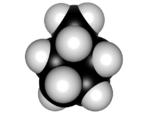Methylcyclopentane: Difference between revisions
Content deleted Content added
fmt ref |
Removed extra period. Tags: Mobile edit Mobile web edit |
||
| Line 44: | Line 44: | ||
}} |
}} |
||
'''Methylcyclopentane''' is an [[organic compound]] with the [[chemical formula]] CH<sub>3</sub>C<sub>5</sub>[[Hydrogen|H]]<sub>9</sub>. It is a colourless, flammable liquid with a faint odor. It is a component of the [[naphthene]] fraction of petroleum. It usually is obtained as a mixture with cyclohexane. It is mainly converted in naphthene [[Catalytic reformer|reformer]]s to [[benzene]] |
'''Methylcyclopentane''' is an [[organic compound]] with the [[chemical formula]] CH<sub>3</sub>C<sub>5</sub>[[Hydrogen|H]]<sub>9</sub>. It is a colourless, flammable liquid with a faint odor. It is a component of the [[naphthene]] fraction of petroleum. It usually is obtained as a mixture with cyclohexane. It is mainly converted in naphthene [[Catalytic reformer|reformer]]s to [[benzene]].<ref name=Ullmann>{{Ullmann|author=M. Larry Campbell|title=Cyclohexane|year=2012|doi=10.1002/14356007.a08_209.pub2}}</ref> The C<sub>6</sub> core of methylcyclopentane is not perfectly planar and can [[Ring_strain|pucker]] to alleviate stress in its structure.<ref>{{cite book |last=Carey |first1=Francis |last2=Giuliano |first2=Robert |title=Organic Chemistry |chapter=3 |edition=9 |publisher=McGraw-Hill |year=2014 |pages=97-131 |isbn=978-0073402741 }}</ref> |
||
:[[File:MeC5H9toPhH.png|center|362px|thumb|The conversion of methylcyclopentane to [[benzene]] is a classic aromatization reaction, specifically a dehydroisomerization. This platinum (Pt)-catalyzed process is practiced on scale in the production of [[gasoline]] from petroleum.]] |
:[[File:MeC5H9toPhH.png|center|362px|thumb|The conversion of methylcyclopentane to [[benzene]] is a classic aromatization reaction, specifically a dehydroisomerization. This platinum (Pt)-catalyzed process is practiced on scale in the production of [[gasoline]] from petroleum.]] |
||
Revision as of 19:37, 2 February 2020
| |||
| Names | |||
|---|---|---|---|
| IUPAC name
Methylcyclopentane
| |||
| Identifiers | |||
3D model (JSmol)
|
|||
| ChEBI | |||
| ChEMBL | |||
| ChemSpider | |||
| ECHA InfoCard | 100.002.277 | ||
| EC Number |
| ||
PubChem CID
|
|||
| UNII | |||
| UN number | 2298 | ||
CompTox Dashboard (EPA)
|
|||
| |||
| |||
| Properties | |||
| C6H12 | |||
| Molar mass | 84.162 g·mol−1 | ||
| Appearance | Colorless liquid | ||
| Density | 0.749 g/cm3[1] | ||
| Melting point | −142.4 °C (−224.3 °F; 130.8 K)[1] | ||
| Boiling point | 71.8 °C (161.2 °F; 344.9 K)[1] | ||
| Insoluble | |||
| -70.17·10−6 cm3/mol | |||
| Hazards | |||
| Occupational safety and health (OHS/OSH): | |||
Main hazards
|
flammable | ||
| Flash point | −4 °C (25 °F; 269 K) | ||
| 260 °C (500 °F; 533 K) | |||
Except where otherwise noted, data are given for materials in their standard state (at 25 °C [77 °F], 100 kPa).
| |||
Methylcyclopentane is an organic compound with the chemical formula CH3C5H9. It is a colourless, flammable liquid with a faint odor. It is a component of the naphthene fraction of petroleum. It usually is obtained as a mixture with cyclohexane. It is mainly converted in naphthene reformers to benzene.[2] The C6 core of methylcyclopentane is not perfectly planar and can pucker to alleviate stress in its structure.[3]

The conversion of methylcyclopentane to benzene is a classic aromatization reaction, specifically a dehydroisomerization. This platinum (Pt)-catalyzed process is practiced on scale in the production of gasoline from petroleum.
References
- ^ a b c Lide, David. R, ed. (2009). CRC Handbook of Chemistry and Physics (89th ed.). CRC Press. ISBN 978-1-4200-6679-1.
- ^ M. Larry Campbell (2012). "Cyclohexane". Ullmann's Encyclopedia of Industrial Chemistry. Weinheim: Wiley-VCH. doi:10.1002/14356007.a08_209.pub2. ISBN 978-3527306732.
- ^ Carey, Francis; Giuliano, Robert (2014). "3". Organic Chemistry (9 ed.). McGraw-Hill. pp. 97–131. ISBN 978-0073402741.


